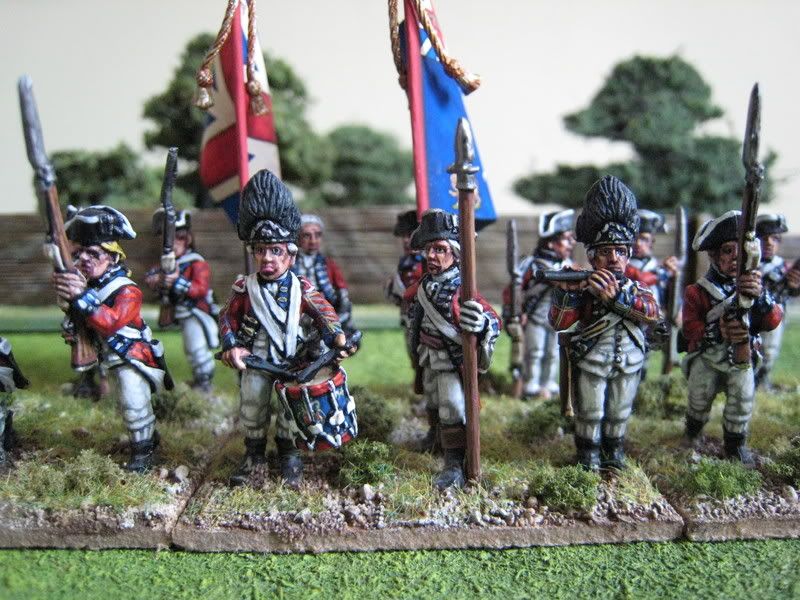
With the 4th Foot completed I now have all the units that fought in Lieutenant General Knyphausen's division at Brandywine, on 11 September 1777. So, in order to inject some proper wargaming into this blog, I thought I would put up some pictures of the whole division and review its constituent parts. This order of battle has a figure ratio of 1:20 scale and is derived from the "British Grenadier" scenario published in Caliver's scenario book, and which also appeared a couple of years ago in "Wargames Illustrated". Brandywine was the largest battle of the AWI. The battle fell into two parts: Knyphausen's divertionary action on the left of the American line and Howe's flanking attack on the right. The latter attack caught Washington unawares and he had to divert troops from his left to reinforce the units fighting Howe. The combinder British attacks led to a collapse of the American position, although the British, as always, failed to deliver a decisive, knock-out blow to the Continental Army. They had come pretty close though. Gaming the whole of Brandywine is a substantial undertaking, both in terms of time and figures required. The two sectors will still individually require more troops than most other scenarios (at 1:20).
The picture above shows the full division. On the left if Major General Grant's brigade; in the centre is Brigadier Cleaveland's artillery battery, behind which is Major General Leslie's brigade of highlanders; on the right is Major General John Vaughan's brigade; to the front of Cleaveland is the advance guard under Wemyss (with dragoons on the left of the shot). Numbers below refer to the number of figures in the unit.
Advance Guard
- 16th Light Dragoons: 6
- Fergusson's Rifles: 6
- Queen's Rangers: 20

Grant's Brigade
- 5th Foot: 16
- 10th Foot: 16
- 27th Foot: 16
- 40th Foot: 16

Cleaveland's Artillery
- howitzers: 2
- 12 pounders: 3

Leslie's Brigade
- 42nd Foot: 24
- 1st Battalion, 71st Foot: 18
- 2nd Battalion, 71st Foot: 18
- 6-pounders: 2
Vaughan's Brigade
- 4th Foot: 18
- 23rd Foot: 18
- 38th Foot: 16
- 49th Foot: 16

There is an optional brigade of Hessians (four regiments), which I have not included above because I haven't painted half of them yet. At the London re-fight of the whole of Brandywine in November 2005, I commanded Grant's brigade and spent most of the game pussy-footing about on the British side of the river. Unless you use Cleaveland's artillery to blast your way across the river, it is very hard to force a successful crossing without taking very heavy casualties. This probably explains why on the day Knyphausen spent most of his time cannonading the American position and only attacked once Howe and Cornwallis were engaged on the American right. The Americans generally did very well at this refight. In the opening moves, Wemyss' advance guard was routed off the table due to a very aggressive attack by the American brigade that began the game on the British side of the river (which itself ceased to exist as a result). On the other side of the field, Cornwallis' attack was not as successful as hoped and became rather bogged down, despite a good performance from the combined grenadier battalions.
Apologies for the lack of posts recently. Something went wrong with Blogger and I couldn't upload photographs until this morning. The weekend should hopefully see photos taken of some American generals, Queen's Rangers artillery, the 21st Foot and some more Perry American artillery. On the painting desk are Hessian jaeger "amusettes", a powder wagon and the 10th Virginia. There are no new AWI releases from Perry Miniatures this month, which is a bit of a relief as I can press on with more Saratoga stuff. But now that the artillery is finished (presumably), one can't help but wonder what will be released next....































